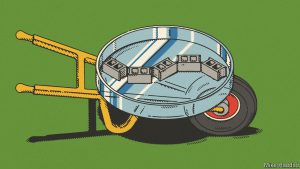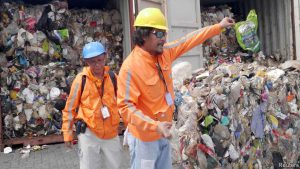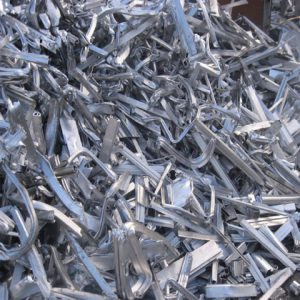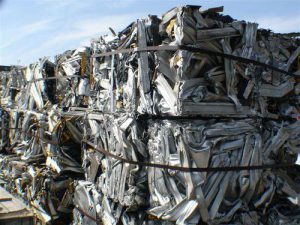The ultimate in waste disposal is to tackle the problem at source
Aug 14th 2018
SIEBEN LINDEN, a hamlet in former East Germany, half-way between Hamburg and Berlin, looks deceptively normal. There is a cluster of houses, some fields, a few cars parked by the side of the road and a small shop, all set against the backdrop of a looming pine forest.
Closer inspection, however, reveals a few peculiarities. Several of the modern-looking buildings turn out to be made of wood, straw and mud. There are huge quantities of logs, because wood-fired stoves and boilers provide all the heating, and quite a few solar panels, which generate most of the electricity. And there are more young people around than usual in rural Germany. Sieben Linden, a self-proclaimed eco-village, is growing fast, unlike the surrounding towns.
The 120 inhabitants have decided to live in as green a manner as possible. They are trying to wean themselves off fossil fuels, grow their own food and timber, acquire fewer frivolous possessions and produce less waste. Food comes either from their own fields or from wholesalers, so there is no need for much packaging. Any scraps are composted. Urine from the toilets is diverted to a reedbed for natural purification, and the faeces are turned into compost for the community’s forest.
The residents live separately but share big appliances such as washing machines and cars. Before buying a new tool, say, they will put a note into the community’s logbook to ask if anybody has one they could borrow. If not, they will probably buy one secondhand. They often wear one another’s hand-me-downs. Unwanted possessions are left out for others to help themselves.
Carefree consumption is not actually forbidden, though it would raise eyebrows, says Eva Stützel, who helped to found Sieben Linden over a decade ago. But the main reason the inhabitants buy less and waste less is that they have a rich community life which does not revolve around trips to shops, restaurants and cinemas. They go ice-skating on a nearby pond in winter and swimming in summer; they teach one another horse-riding and yoga and tai chi; they put on plays and concerts and seminars.
The idea, explains Kosha Joubert, another resident, is not to adopt a dreary, ascetic lifestyle but to demonstrate that it is possible to live in a green manner without undue sacrifice or disruption. Western urbanites could easily adopt elements of the eco-village lifestyle, she says, by forming car pools, say, or shopping co-operatives.
Tipping point
Until recently most people in the waste industry had assumed that it was impossible to reduce the amount being produced and were concentrating on putting the stuff to better use. But lately that assumption has been challenged. For one thing, the pace at which the rich world churns out rubbish has been slowing.
Between 1980 and 2000 the amount of waste produced by the OECD countries increased by an average of 2.5% a year. Between 2000 to 2005 the average growth rate slowed to 0.9%. That was just ahead of the rate of population growth (0.7%), but well behind the rate of economic growth (2.2%). The OECD describes this as “a rather strong relative decoupling of municipal waste generation from economic growth”, although it expresses some misgivings about the reliability of the data. The European Union has detected a similar trend in several European countries, as has CyclOpe, the research institute.
Reducing the amount of waste being produced makes a great deal of sense, provided it does not cost more, in either environmental or financial terms, than disposing of it in the usual way. Governments hope it might help to trim both greenhouse-gas emissions and waste-management costs. But they are not sure how best to encourage it.
Some are trying to persuade consumers to throw away less. The simplest method is to collect the rubbish less often. In areas of Britain where the dustmen come round only every other week, recycling rates are 10% higher than elsewhere.
Another tactic is to make households pay by volume for the rubbish they generate, rather than through a flat fee or through local taxes. Many places in Europe, America and Asia have adopted “pay-as-you-throw” schemes. (In Taiwan, householders even have to chuck their own rubbish into the truck.) About a quarter of Americans live in communities with such programmes. The EPA reckons that they reduce the volume of rubbish by 14-27% and increase recycling (which usually remains free) by 32-59%.
There are drawbacks. Fly-tipping—the illegal dumping of waste—tends to rise slightly as people try to avoid paying. And householders generally grumble a lot if they have to pay extra to have their rubbish collected. Some communities have responded by offering rebates to those who throw away less—a more palatable way of packaging the same idea. But most local authorities have simply decided against the idea. When the British government offered them money to experiment with pay-as-you-throw schemes earlier this year, not one signed up.
Businesses are generally seen as a softer target than consumers. It can be argued that manufacturers bear some responsibility for the amount of waste rich countries produce. They often have an incentive to reduce waste anyway, since most already pay for disposal by volume. There is even a name for the steady reduction in materials used to make the same goods: “lightweighting”. It is not only electronic gadgets that have become smaller and lighter over the years even as their performance has improved but many other things too, from cars to plastic bags.
A lifestyle choice at Sieben Linden
The average aluminium drink can is now only half as thick as it was in the 1960s, according to Molson Coors, the firm that introduced this type of container in 1959. Its American subsidiary has reduced the weight of its cans by 7% in the past five years alone. That means savings not only on the metal itself but also on transport and even cooling: thinner cans chill faster.
Officials in the EU, in particular, are keen to hurry lightweighting along. WRAP, the British agency charged with reducing waste, is trying to promote it for various sorts of packaging. It funded trials of a lightweight pull-tab lid for food tins, which it believes could save 15,000 tonnes of steel each year in Britain alone. Heinz, a giant food manufacturer which took part in the trial, hopes that adopting the new lids will save it £400,000 a year. WRAP has conducted similar tests of thinner glass and plastic bottles, with equally promising results.
WRAP also cajoled Britain’s biggest supermarkets and food suppliers into signing a voluntary agreement to halt the growth in packaging by last year and start reducing it from 2010. Last July it announced that the initial target had been met, despite a 1.8% rise in sales. Some firms are going much further: in 2007 Tesco pledged to reduce its packaging by a quarter by 2010.
In theory, consumers could steer firms towards waste reduction by buying products that are easy to recycle, say, or have only minimal packaging. To some extent this is happening. Tesco’s Alasdair James says British consumers rank the environment as their third priority after price and convenience. But many governments are trying to give greenery an extra push with compulsory waste-reduction schemes. Some levy fees on certain products, akin to bottle deposits, to ensure they are disposed of safely. Thirty-six states in America, for example, charge for the disposal of tyres. The states spend the money on clean-up programmes or pay others to run such programmes. Many of the tyres are blended into road surfaces or burned in cement kilns. Several other states have “advance recovery fees” for computer monitors and televisions. So have Japan, South Korea and Taiwan, among others, and China is working on a scheme.
The problem with fee programmes is that all goods in a category are subject to the same charge, whether they are easy or hard to get rid of. That gives manufacturers no incentive to build easy disposal into the design of a product.
One answer is to ban certain substances outright, thereby eliminating the need to dispose of them later. A number of places, from San Francisco to the tiny Himalayan kingdom of Bhutan, have banned or severely restricted the use of plastic bags. The EU barred the use of several heavy metals and flame retardants in electronic goods in 2006 and recently proposed expanding the scheme. Several American states were so impressed that they have copied the EU’s rules.
Return to sender
But the EU has gone further, applying a concept called “extended producer responsibility” to an ever-expanding list of items including cars and computers. At its simplest, this means that manufacturers have to take back their products without charge when consumers have finished with them. The EU’s directive on “end-of-life vehicles” not only obliges manufacturers to accept vehicles that are no longer wanted, but also requires them to recycle or re-use 80% of the parts by weight, a proportion that will rise to 85% by 2015. The manufacturers can farm out the job, but only to authorised firms.
Hewlett-Packard (HP), which makes lots of electronic devices that are subject to such rules, says it welcomes them. It has always tried to design its products not just from cradle to grave, a spokesman explains, but from cradle to cradle—meaning with recycling in mind. Its laptops are 90% recyclable and its printers at least 70%. By last year HP had recycled over 450,000 tonnes of used equipment. It aims to double that figure by the end of next year. At its facility in Roseville, California, workers first check discarded computers and printers to see if they can be re-used: it refurbishes 2.5m devices a year. The rest are taken to bits. First the big, accessible parts are removed, along with anything dangerous, and then heavy-duty shredders grind up the remainder into tiny pieces that can be sorted by standard recycling equipment.
An engineer explains how a decade of such work has taught HP how to make the process simpler and cheaper. It now uses screws instead of glues wherever possible, and has reduced the number of different kinds of plastic in its products from 200 to five. It plans to eliminate one more—polyvinyl chloride—from new computer models this year. It is proud of having closed the loop on ink cartridges for its printers, which it now makes from old cartridges.
But the firm would like to go further, designing computers so that they can be easily upgraded rather than replaced. Ultimately, says Chandrakant Patel, who heads its “sustainable IT ecosystems laboratory”, modern computer systems will allow firms to calculate the precise disposal costs of a product during the design phase and include them in the sale price. More sophisticated products will also warn users when they are about to fail, eliminating the need for spare capacity.
Think before you legislate
Sadly, however, that sort of world is still a long way off. Governments are wildly inconsistent in their approach to extended producer responsibility. They tend to home in on particular products without justification (tyres, after all, are not among the biggest threats to the planet). Their goals seem arbitrary too: how did the EU decide that 85% of car parts had to be recycled, not 84% or 86%? And why should the deadline be 2015, not some other year?
Official thinking about waste in general seems equally confused. Why levy deposits to encourage the recycling of glass bottles but not plastic ones? Why control the disposal of municipal waste in such detail but allow utilities to pile up coal ash unchallenged? Why tax and regulate landfills out of all proportion to the damage they do to the environment? The individual policies do not add up to a grand design.
It doesn’t have to be like this
A desire to reduce the amount of waste being produced and to minimise the harm it does is all well and good, but governments must be sure to encourage those ends by the cheapest and most efficient means. Plugging loopholes in the rules is a good first step. American officials should be much stricter about coal-ash tips, regardless of how much clout utilities have in Congress. Similarly, governments should pay more attention to waste that winds up in the sea, even if it falls outside their formal jurisdiction.
Emissions of greenhouse gases and other noxious chemicals are a worry. But instead of banning or heavily taxing particular waste-disposal technologies to reduce the emissions they produce, governments should tax or limit emissions in general. That would steer investors towards the cleanest technologies, whatever they might be. Thus, instead of clamping down on landfills because of the methane they produce, or incinerators for fear of dioxins, governments should tackle methane and dioxins across the board. If landfills and incinerators can meet the standards they set, they should be welcomed.
Putting a price on greenhouse-gas emissions would also help to promote recycling. At the moment, it is often cheaper to process virgin materials, despite the extra energy required, because collecting and sorting recyclables is so labour-intensive. Recycling produces far fewer greenhouse gases, but recycling firms do not get much benefit out of that because their rivals pay little or nothing for the emissions they produce. In effect, governments are subsidising the use of raw materials by failing to charge big energy users for the emissions they cause. Scrapping that subsidy would provide recycling firms with a big boost.
Above all, regulators should be conscious of the costs of the rules they lay down. Blanket bans, 100% targets and punitive taxes are usually a sign of dogmatism. It cannot be desirable for California to recycle absolutely everything. There must be some waste that is better burnt or buried. Construction and demolition, for example, produce lots of inert waste that can be cheaper to put into landfill than to “downcycle” into lower-value construction materials. And there is nothing wrong with burning wood or even some plastics, provided the right pollution controls are in place. Politicians should prize value for money above political correctness or rhetorical flourish.
Still, in their muddled and heavy-handed way, governments are groping towards the idea of making the polluter pay by internalising the cost of responsible waste disposal. That is surely the right way to go. If governments oblige manufacturers to include the cost of disposal in their prices, firms will pass those costs on to consumers, who will have an incentive to buy the products that are the easiest to dispose of and therefore cheapest. All this should provide a spur to the waste industry and speed the adoption of new technology. Firms like HP have seen the writing on the wall: waste is heading for a redesign.
This article was published in The Economist on Aug 14th 2018.
Link: https://www.economist.com/special-report/2018/08/14/less-is-more





